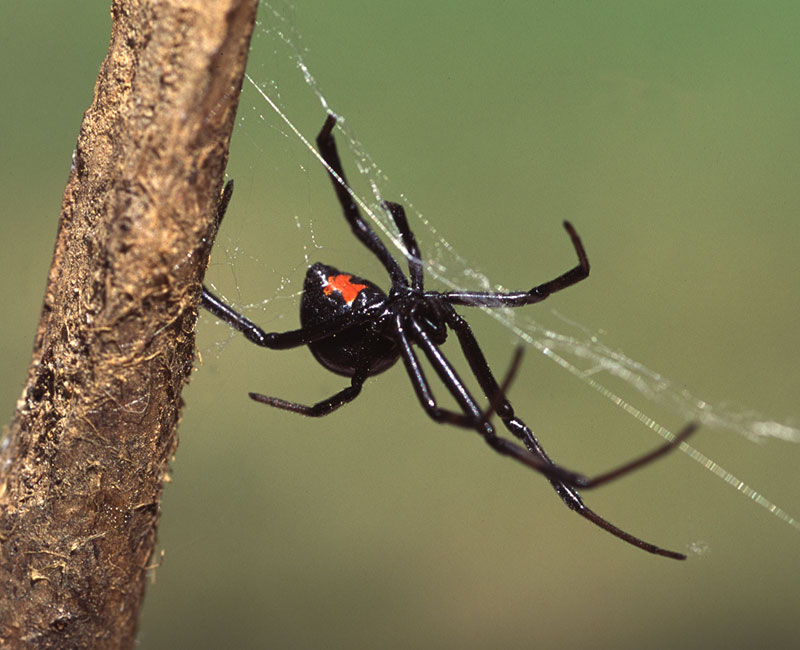The black widow is a type of spider with a shiny black body. Females have a red hourglass marking on their bellies. A female black widow spider bite can be dangerous. A bite from a female releases a toxic venom that attacks your nerve endings, causing severe muscle aches and pains. If you think a black widow bit you, seek medical care right away.
Advertisement
Cleveland Clinic is a non-profit academic medical center. Advertising on our site helps support our mission. We do not endorse non-Cleveland Clinic products or services. Policy

The black widow spider is an eight-legged arachnid with a shiny black body that ranges from 1/4 inch to 1 3/8 inches long. Female black widows have a distinctive red hourglass-shaped marking on the underside of their bodies. Females are larger and more dangerous than males. Black widows get their name from the myth that the females eat the males after mating, leaving them “widowed,” but this rarely happens.
Advertisement
Cleveland Clinic is a non-profit academic medical center. Advertising on our site helps support our mission. We do not endorse non-Cleveland Clinic products or services. Policy
Black widow spiders mostly live in warm, dry climates in the Southern and Western U.S., but they can be found in all states except Hawaii and Alaska.
Black widows primarily live outdoors, where they build webs near garages, fences, woodpiles, building overhangs and other outdoor structures. They like to hide out in gardening equipment, outdoor furniture and garbage, as well. You may also find them in cluttered areas such as basements, closets, attics and under sinks.
Black widow spiders are a member of the Latrodectus family. People report about 2,600 Latrodectus-species bites to the National Poison Data System every year.
Black widow spiders have large fangs and glands that produce very toxic venom. When bitten, the venom attacks the nerve endings in your muscles, causing symptoms such as severe, bodywide muscle pain and cramping. However, only the female black widow bites. The males are too small and can’t break through human skin. Black widow spider bites typically occur when humans come into direct contact with their webs. They only bite when threatened.
A black widow spider bite causes a sharp, pinprick-like pain. A dull numbness in the bite area may follow. Black widow spider venom interferes with chemicals in your nerve endings. This can produce severe pain, stiffness and muscle spasms throughout your body, including your belly (abdomen), shoulders, chest and back.
Advertisement
Other black widow spider bite symptoms may include:
You may see tiny red fang marks where the spider bit you. You may also have mild redness and swelling in the bite area. A blister may form, or you may have an itchy skin rash. In addition, your skin may turn bluish-gray (cyanosis) at the bite site.
Male black widow spiders rarely bite. They’re too small and not able to break your skin with their fangs. But female black widows may bite in defense, especially after they lay eggs. Most spider bites are accidents. If you accidentally brush up against a spider, it’s just trying to defend itself. They don’t purposely try to attack you.
You can get a skin condition called cellulitis from a spider bite. Cellulitis occurs when bacteria enter your skin and cause an infection.
Rarely, some people have long-term pain or muscle spasms after black widow spider bites.
Healthcare providers can’t identify a particular spider based on its bite mark. There are no tests to confirm what kind of spider bit you. If you have the spider, bring it with you for confirmation. However, most of the time, you won’t have the spider. Providers usually diagnose a spider bite based on your symptoms.
If you think a black widow spider bit you:
Treatment for a black widow spider bite may include:
Black widow bites are serious. Children younger than 16 and people older than 60 may need hospitalization to treat:
Some people are allergic to the antivenom providers use to treat spider bites. This is rare, but in these cases, anaphylaxis can occur.
Advertisement
The prognosis for black widow bites is generally good. With prompt treatment, you should make a full recovery within 24 to 48 hours. Some people experience long-term pain or muscle spasms after black widow bites, but this is rare.
You can reduce your risk of a black widow spider bite by minimizing the clutter in your basement, attic and/or garage. This can help eliminate their hiding spots. Other ways to prevent black widow spider bites include:
After treatment for a black widow spider bite, you should return to the emergency department if the following symptoms develop:
If you were bitten by a black widow spider, you may want to ask your healthcare provider the following questions:
Advertisement
Black widow spiders have a bad reputation. But like all spiders, they really don’t want to bite you. They only bite when they feel the need to defend themselves. To avoid a black widow spider’s wrath, clear the clutter in your garage, basement and attic. And wear gloves if you’re working in an area that may have spiders. You should seek immediate medical attention if a black widow spider bites you.
Advertisement
Whether you need stitches, a broken bone set or think your appendix might be causing your abdominal pain, Cleveland Clinic’s emergency medicine team is here to help.

Last reviewed on 11/09/2023.
Learn more about the Health Library and our editorial process.